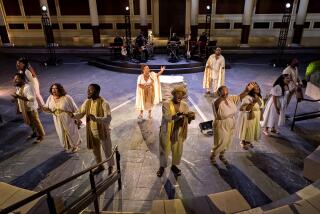Ancient pottery at Getty Villa captures spirit of Greek theater
- Share via
Sex and violence dominated the entertainments of the ancient Greeks, as we can see from depictions on the terra-cotta vessels in “The Art of Ancient Greek Theater” through Jan. 3 at the Getty Villa. There are scene after scene of characters with drawn weapons and murderous intent, as well as exposed, sometimes exaggerated, male parts.
Here’s Orestes on a 4th century BC amphora about to kill his mother Clytemnestra, grabbing her by the hair. She appeals for mercy by cupping a breast, trying to remind him of his origins (to no avail). There’s sorceress Medea on another amphora, stabbing her son as he grimaces and spurts blood. It’s revenge on her cheating husband, Jason, who’s returned from one of his adventures with a younger, more docile new wife.
Though the slayings happened offstage in the tragedies of Euripides, Aeschylus and Sophocles during the Golden Age of Greek drama in the 5th century BC, the vessels, mostly commissioned for wine drinking and storage, seem not to have that constraint. Greek theater rose as part of the worship of Dionysus, also the god of wine and fertility. “The [early] theaters are all devoted to Dionysus, and they were called theatron, which meant ‘the seeing place,’” says exhibition curator Mary Louise Hart of the Getty’s Department of Antiquities.
Originally, the plays were performed once, in a prestigious annual competition. “You have three days of theatrical competition, one for each playwright, each with a trilogy of plays and a satyr play.” The satyr play retold familiar stories with burlesque characters who often wore fake phalluses, as seen in a number of objects in the exhibition.
Hart has been working on the show for seven years, eventually culling 95 objects from 25 lenders, many of them from abroad. The black-and-red vessels depict scenes from the literature from which the plays were taken, as well as stagecraft — some show actors in obvious costumes or standing on an elevated platform that would have been the stage. One of the most famous kraters, “Dionysos and the Cast of a Satyr Play,” even shows a kind of cast party, with the god lounging with his consort Ariadne while flanked by actors holding their masks.
There are also terra-cotta and bronze figurines of actors and masks, as well as an extraordinarily rare 2nd century papyrus fragment — on it are lines from “The Trackers,” one of Sophocles’ satyr plays. “It is always astounding that 70% of the ancient literature that has survived came from a garbage dump in Northern Egypt from a place called Oxyrhynchus,” Hart says dryly.
“Elektra,” the Sophocles play that was mounted at the Getty Villa this summer, pivots on murder most foul. As Carey Perloff, the play’s guest director and artistic director of San Francisco’s American Conservatory Theater, quotes from the text, “‘Trickery acted but lust conceived the act.’” “The Greeks went to the theater to wrestle with the big questions,” she says. “What is the nature of justice? What is the relationship of the individual to society? How to behave when fate or the gods are so fickle?”
Perloff believes one can learn much about Greek drama from the vessels. “The urns give you insight into how the plays were performed and which stories resonated the most,” she says. “Also what the dancing looks like, what the instruments were like. It makes it very vivid and real.”
calendar@latimes.com
More to Read
The biggest entertainment stories
Get our big stories about Hollywood, film, television, music, arts, culture and more right in your inbox as soon as they publish.
You may occasionally receive promotional content from the Los Angeles Times.










